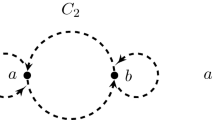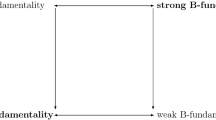Abstract
An argument going back to Russell shows that the view that propositions are structured is inconsistent in standard type theories. Here, it is shown that such type theories may nevertheless provide entities which can serve as proxies for structured propositions. As an illustration, such proxies are applied to the case of grounding, as standard views of grounding require a degree of propositional structure which suffices for a version of Russell’s argument. While this application solves some of the problems grounding faces, it introduces problematic limitations: it becomes impossible to quantify unrestrictedly over the relata of ground. The proposed proxies may thus not save grounding, but they shed light on what exactly Russell’s argument does and does not show.
Similar content being viewed by others
References
Audi, P. (2012). Grounding: Toward a theory of the in-virtue-of relation. The Journal of Philosophy, 109, 685–711.
Church, A. (1984). Russell’s theory of identity of propositions. Philosophia Naturalis, 21, 513–522.
Correia, F. (2014). Logical grounds. The Review of Symbolic Logic, 7, 31–59.
Deutsch, H. (2008). Review of The Nature and Structure of Content by Jeffrey C. King. Notre Dame Philosophical Reviews.
Donaldson, T. (2017). The (metaphysical) foundations of arithmetic? Noûs, 51, 775–801.
Dorr, C. (2004). Non-symmetric relations. Oxford Studies in Metaphysics, 1, 155–192.
Dorr, C. (2016). To be F is to be G. Philosophical Perspectives, 30, 39–134.
Fine, K. (1981). Model theory for modal logic: Part III. Existence and predication. Journal of Philosophical Logic, 10, 293–307.
Fine, K. (2000). Neutral relations. The Philosophical Review, 109, 1–33.
Fine, K. (2010). Some puzzles of ground. Notre Dame Journal of Formal Logic, 51, 97–118.
Fine, K. (2012). Guide to ground. In F. Correia & B. Schnieder (Eds.), Metaphysical grounding (pp. 37–80). Cambridge: Cambridge University Press.
Fritz, P. (forthcoming). On higher-order logical grounds. Analysis.
Fritz, P. (unpublished). Ground and grain.
Fuhrmann, A. (2002). Russell’s way out of the paradox of propositions. History and Philosophy of Logic, 23, 197–213.
Goldfarb, W. (1989). Russell’s reasons for ramification. In C. W. Savage & C. A. Anderson (Eds.), Rereading Russell: Essays in Bertrand Russell’s metaphysics and epistemology (pp. 24–40). Minneapolis: University of Minnesota Press.
Hindley, J. R., & Seldin, J. P. (2008). Lambda-calculus and combinators: An introduction. Cambridge: Cambridge University Press.
Hodes, H. T. (2015). Why ramify? Notre Dame Journal of Formal Logic, 56, 379–415.
Klement, K. C. (2001). Russell’s paradox in Appendix B of the Principles of Mathematics: Was Frege’s response adequate? History and Philosophy of Logic, 22, 13–28.
Klement, K. C. (2003). The number of senses. Erkenntnis, 58, 303–323.
Kripke, S. A. (2011). A puzzle about time and thought. In S. Kripke (Ed.), Philosophical troubles (pp. 373–379). Oxford: Oxford University Press.
Krämer, S. (2013). A simpler puzzle of ground. Thought, 2, 85–89.
Linsky, B. (1999). Russell’s metaphysical logic. Stanford: CSLI Publications.
Myhill, J. (1958). Problems arising in the formalization of intensional logic. Logique et Analyse, 1, 78–83.
Rosen, G. (2010). Metaphysical dependence: Grounding and reduction. In B. Hale & A. Hoffmann (Eds.), Modality: Metaphysics, logic, and epistemology (pp. 109–136). Oxford: Oxford University Press.
Russell, B. (1903). The principles of mathematics. Cambridge: Cambridge University Press.
Salmon, N. (1987). Existence. Philosophical Perspectives, 1, 49–108.
Schnieder, B. (2010). A puzzle about ‘because’. Logique and Analyse, 211, 317–343.
Stalnaker, R. (2012). Mere possibilities. Princeton: Princeton University Press.
Whitehead, A. N., Russell, B. (1910–1913). Principia mathematica (Vols. 1–3). Cambridge: Cambridge University Press.
Williamson, T. (1985). Converse relations. The Philosophical Review, 94, 249–262.
Williamson, T. (2013). Modal logic as metaphysics. Oxford: Oxford University Press.
Woods, J. (2018). Emptying a paradox of ground. Journal of Philosophical Logic, 47, 631–648.
Acknowledgements
For very helpful discussion and comments on drafts of this paper and its (in some cases distant) precursors, I would like to thank Andrew Bacon, Luke Burke, Cian Dorr, Jeremy Goodman, Bryan Pickel, Jim Pryor, Gabriel Uzquiano, Natalia Waights Hickman, Clas Weber, Juhani Yli-Vakkuri, two anonymous referees for Synthese, several anonymous referees for other journals, and audiences at the Universities of Agder, Oslo, Edinburgh, Bielefeld, and Glasgow. Special thanks to Harvey Lederman who, in comments on an earlier version, recommended pursuing the application of t-complexes to grounding; this led not only to the development of the second half of this paper, but also to several other papers, including Fritz (unpublished) and Fritz (forthcoming).
Author information
Authors and Affiliations
Corresponding author
Additional information
Publisher's Note
Springer Nature remains neutral with regard to jurisdictional claims in published maps and institutional affiliations.
Appendix
Appendix
Let P be the set of instances of the following schema:
-
\(P_t\bar{\varepsilon }=\pi _\varepsilon \) (for \(t=\tau _\varepsilon \))
We show that P is consistent with classical logic by a standard model construction.
Standard models for functional type theory associate each type with a domain, containing the denotations of expressions of the relevant type. In the simplest models, the domain of type s is \(\{0,1\}\), with 0 representing falsity and 1 representing truth, and for any functional type \((t_1\rightarrow t_2)\), the domain of type \((t_1\rightarrow t_2)\) is the set of functions from the domain of type \(t_1\) to the domain of type \(t_2\). In this very simple setting, a model is given by a set D, serving as the domain of type i, and an interpretation function I, mapping each constant c of some type to an element I(c) of the domain of that type. Such an interpretation function I is extended to map each expression, simple or complex, to an element of the domain of its type: writing \([e]_M\) for the interpretation of an expression e in a model M consisting of an individual domain D and an interpretation function I, let, for any constant c and complex expression (fa):
-
\([c]_M=I(c)\)
-
\([(fa)]_M=[f]_M([a]_M)\)
Call \([e]_M\) the denotation of e (in M). Such a model validates the principles of classical logic if it interprets the logical constants in the expected way. E.g., in the case of \(\lnot \), this means mapping 0 to 1 and vice versa. For the following, we assume furthermore that there is a term \(\bar{\varepsilon }\) of type i for every term \(\varepsilon \), and that I interprets it as intended, i.e., as the expression \(\varepsilon \). This requires, of course, that D contains all expressions of the language. Call models satisfying these constraints standard.
We show that there are standard models in which every member of P is true (i.e., mapped to 1). In fact, we show something slightly stronger: Let L be a language based on a choice of constants including \(P_t\), for all types t, and \(L_0\) the sublanguage obtained by omitting the constants \(P_t\). We show that any standard model for a language \(L_0\) can be extended to a model of L which verifies the members of P.
So let \(M_0\) be a standard model of \(L_0\). We specify the interpretation of \(P_t\) in a sequence of steps corresponding to the complexity of t. Inductively define the rank of a type t, written r(t), as follows:
-
\(r(i)=r(s)=0\)
-
\(r(t_1\rightarrow t_2)=\mathrm {max}(r(t_1),r(t_2))+1\)
Let \(L_n\) be the extension of \(L_0\) by the constants \(P_t\) with \(r(t)<n\); thus \(L_{n+1}\) extends \(L_n\) by the constants \(P_t\) with \(r(t)=n\). Based on \(M_0\), we define a sequence of models \(M_n\) of \(L_n\) by induction on the natural numbers, writing \(I_n\) for the interpretation function of \(M_n\). Let \(I_{n+1}\) agree with \(I_n\) on all constants in \(L_n\). For the remaining constants, i.e., for any \(P_t\) with \(r(t)=n\), let \(I_{n+1}(P_t)\) be some function in the domain of \(\langle i,t\rangle \) such that for all constants c of type t and complex expressions \(\varepsilon \eta \) with \(\tau _{\varepsilon \eta }=t\):
-
\(I_{n+1}(P_t)(c)=I_n(c)\)
-
\(I_{n+1}(P_t)(\varepsilon \eta )(x)(y)={\left\{ \begin{array}{ll} 1 &{} \text {if } x=I_n(P_{\tau _\varepsilon })(\varepsilon ) \text { and } y=I_n(P_{\tau _\eta })(\eta ) \\ 0 &{} \text {otherwise} \end{array}\right. }\)
for all x in the domain of type \(\tau _\varepsilon \) and y in the domain of type \(\tau _\eta \)
Note that \(I_n\) is defined on the required constants in these definitions: For the first equation, consider \(c=P_{t'}\). Then \(t=i\rightarrow t'\), so \(r(t')=r(t)-1\). Thus \(I_n=I_{r(t')+1}\) is defined on \(P_{t'}=c\). For the second equation, \(r(\tau _\varepsilon ),r(\tau _\eta )<r(\tau _{\varepsilon \eta })=n\), so \(I_n\) is defined on \(P_{\tau _\varepsilon }\) and \(P_{\tau _\eta }\).
Finally, let M be the model of L extending \(M_0\) whose interpretation function I maps each constant \(P_t\) to \(I_{r(t)+1}(P_t)\). By construction, \(I_n(P_t)\) is the same function for all \(n>r(t)\). Thus the two equations just used to define \(I_{n+1}\) hold when both \(I_{n+1}\) and \(I_n\) are replaced by I, from which it follows that M verifies P.
Rights and permissions
About this article
Cite this article
Fritz, P. Structure by proxy, with an application to grounding. Synthese 198, 6045–6063 (2021). https://doi.org/10.1007/s11229-019-02450-z
Received:
Accepted:
Published:
Issue Date:
DOI: https://doi.org/10.1007/s11229-019-02450-z




